Report on Quality Management and Organizational Excellence Strategies
VerifiedAdded on 2023/01/12
|11
|3576
|53
Report
AI Summary
This report delves into the realm of quality management and its impact on organizational excellence, using Quality Tooling Company (QTC) as a case study. It explores the fundamental concepts of quality, emphasizing the significance of customer perception and adherence to standards for achieving excellence. The report examines the crucial role of quality management techniques, including Total Quality Management (TQM) and Quality Assurance (QA), in enhancing processes and attracting customers. The core of the report focuses on TQM principles like customer focus, employee empowerment, and continuous improvement, along with the application of the PDCA cycle. Furthermore, it outlines the importance of quality assurance, statistical control, and the implementation of quality standards. By analyzing QTC's approach, the report provides insights into how organizations can foster a culture of sustainability and achieve higher levels of operational efficiency and customer satisfaction through effective quality management strategies.
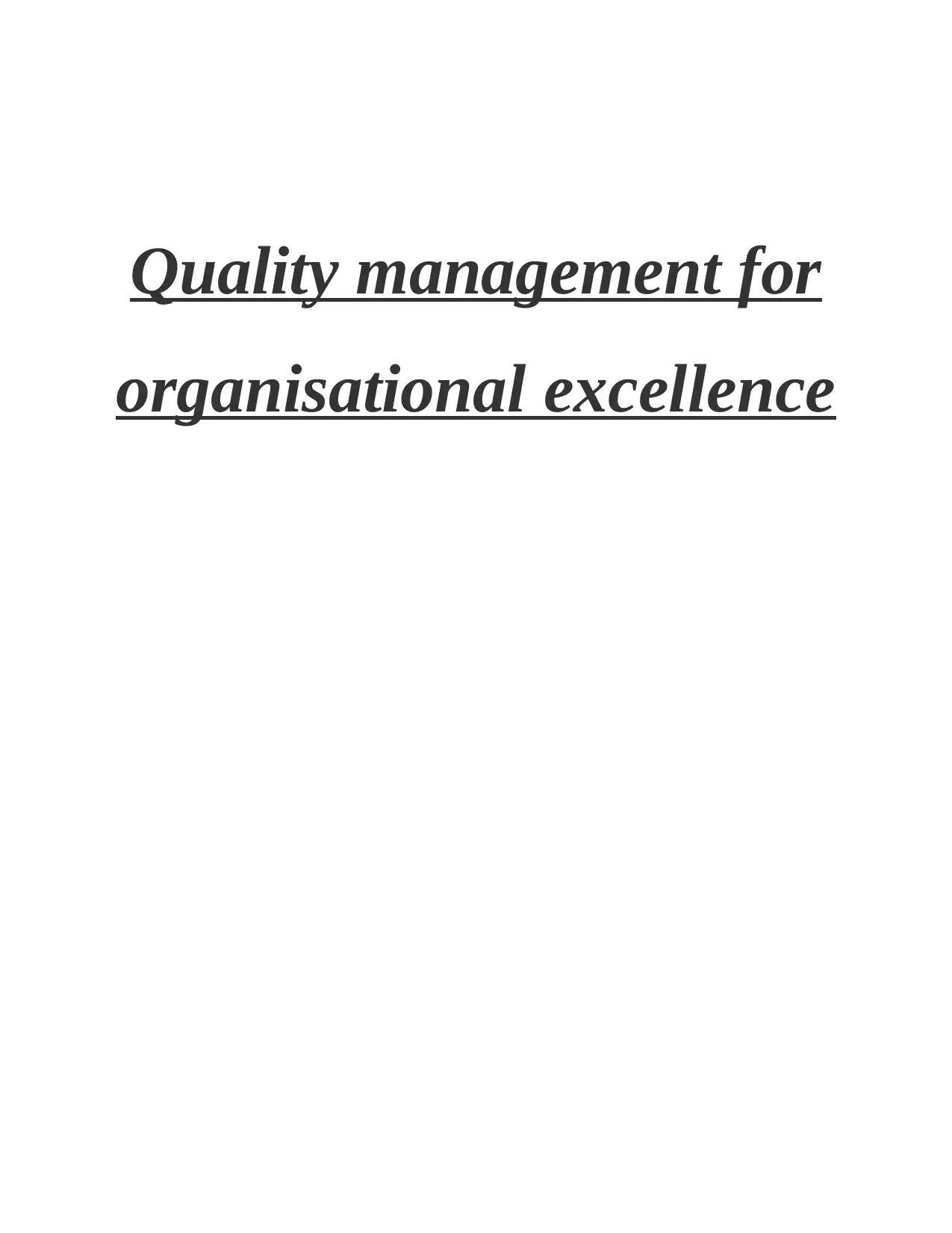
Quality management for
organisational excellence
organisational excellence
Paraphrase This Document
Need a fresh take? Get an instant paraphrase of this document with our AI Paraphraser
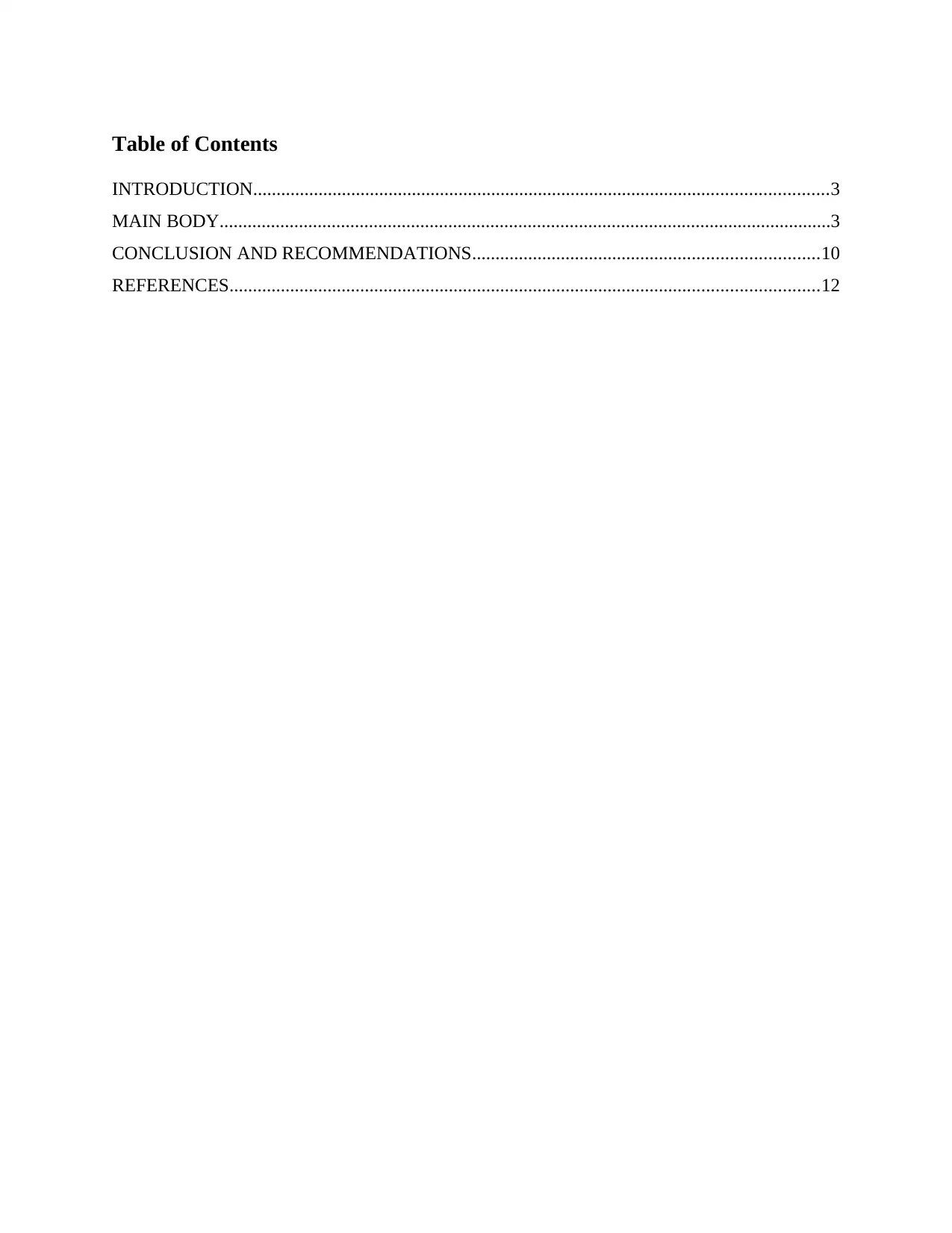
Table of Contents
INTRODUCTION...........................................................................................................................3
MAIN BODY...................................................................................................................................3
CONCLUSION AND RECOMMENDATIONS..........................................................................10
REFERENCES..............................................................................................................................12
INTRODUCTION...........................................................................................................................3
MAIN BODY...................................................................................................................................3
CONCLUSION AND RECOMMENDATIONS..........................................................................10
REFERENCES..............................................................................................................................12
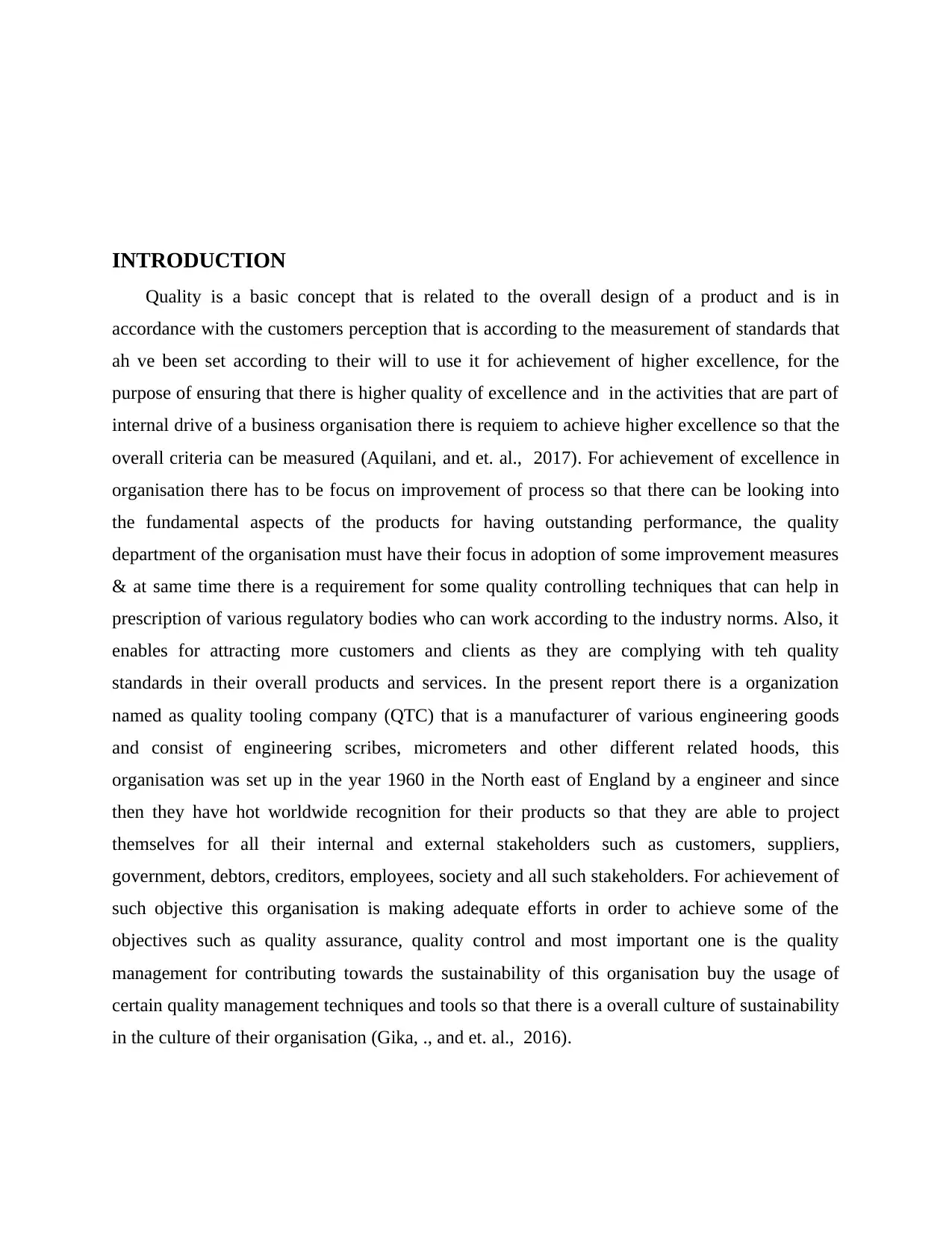
INTRODUCTION
Quality is a basic concept that is related to the overall design of a product and is in
accordance with the customers perception that is according to the measurement of standards that
ah ve been set according to their will to use it for achievement of higher excellence, for the
purpose of ensuring that there is higher quality of excellence and in the activities that are part of
internal drive of a business organisation there is requiem to achieve higher excellence so that the
overall criteria can be measured (Aquilani, and et. al., 2017). For achievement of excellence in
organisation there has to be focus on improvement of process so that there can be looking into
the fundamental aspects of the products for having outstanding performance, the quality
department of the organisation must have their focus in adoption of some improvement measures
& at same time there is a requirement for some quality controlling techniques that can help in
prescription of various regulatory bodies who can work according to the industry norms. Also, it
enables for attracting more customers and clients as they are complying with teh quality
standards in their overall products and services. In the present report there is a organization
named as quality tooling company (QTC) that is a manufacturer of various engineering goods
and consist of engineering scribes, micrometers and other different related hoods, this
organisation was set up in the year 1960 in the North east of England by a engineer and since
then they have hot worldwide recognition for their products so that they are able to project
themselves for all their internal and external stakeholders such as customers, suppliers,
government, debtors, creditors, employees, society and all such stakeholders. For achievement of
such objective this organisation is making adequate efforts in order to achieve some of the
objectives such as quality assurance, quality control and most important one is the quality
management for contributing towards the sustainability of this organisation buy the usage of
certain quality management techniques and tools so that there is a overall culture of sustainability
in the culture of their organisation (Gika, ., and et. al., 2016).
Quality is a basic concept that is related to the overall design of a product and is in
accordance with the customers perception that is according to the measurement of standards that
ah ve been set according to their will to use it for achievement of higher excellence, for the
purpose of ensuring that there is higher quality of excellence and in the activities that are part of
internal drive of a business organisation there is requiem to achieve higher excellence so that the
overall criteria can be measured (Aquilani, and et. al., 2017). For achievement of excellence in
organisation there has to be focus on improvement of process so that there can be looking into
the fundamental aspects of the products for having outstanding performance, the quality
department of the organisation must have their focus in adoption of some improvement measures
& at same time there is a requirement for some quality controlling techniques that can help in
prescription of various regulatory bodies who can work according to the industry norms. Also, it
enables for attracting more customers and clients as they are complying with teh quality
standards in their overall products and services. In the present report there is a organization
named as quality tooling company (QTC) that is a manufacturer of various engineering goods
and consist of engineering scribes, micrometers and other different related hoods, this
organisation was set up in the year 1960 in the North east of England by a engineer and since
then they have hot worldwide recognition for their products so that they are able to project
themselves for all their internal and external stakeholders such as customers, suppliers,
government, debtors, creditors, employees, society and all such stakeholders. For achievement of
such objective this organisation is making adequate efforts in order to achieve some of the
objectives such as quality assurance, quality control and most important one is the quality
management for contributing towards the sustainability of this organisation buy the usage of
certain quality management techniques and tools so that there is a overall culture of sustainability
in the culture of their organisation (Gika, ., and et. al., 2016).
⊘ This is a preview!⊘
Do you want full access?
Subscribe today to unlock all pages.

Trusted by 1+ million students worldwide
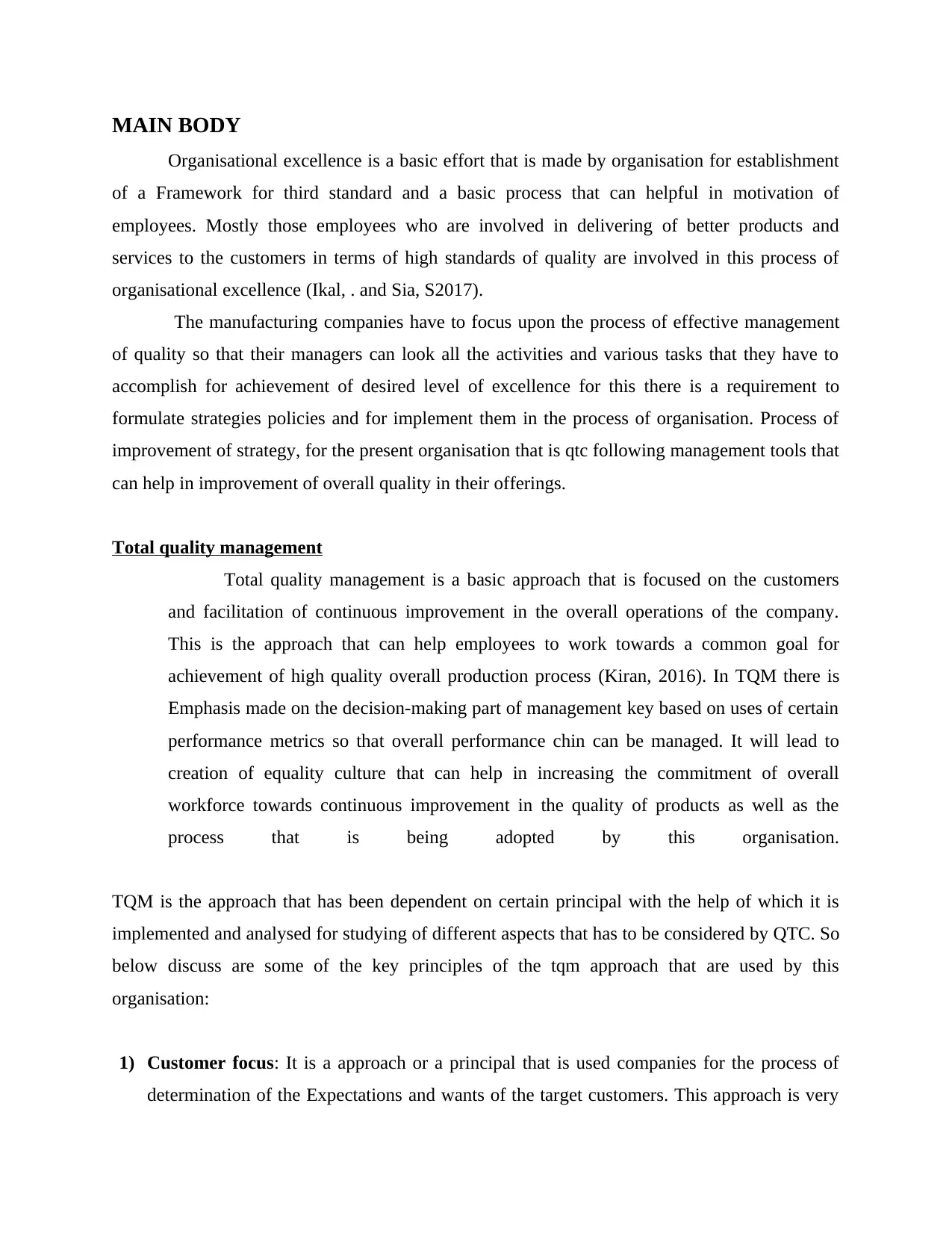
MAIN BODY
Organisational excellence is a basic effort that is made by organisation for establishment
of a Framework for third standard and a basic process that can helpful in motivation of
employees. Mostly those employees who are involved in delivering of better products and
services to the customers in terms of high standards of quality are involved in this process of
organisational excellence (Ikal, . and Sia, S2017).
The manufacturing companies have to focus upon the process of effective management
of quality so that their managers can look all the activities and various tasks that they have to
accomplish for achievement of desired level of excellence for this there is a requirement to
formulate strategies policies and for implement them in the process of organisation. Process of
improvement of strategy, for the present organisation that is qtc following management tools that
can help in improvement of overall quality in their offerings.
Total quality management
Total quality management is a basic approach that is focused on the customers
and facilitation of continuous improvement in the overall operations of the company.
This is the approach that can help employees to work towards a common goal for
achievement of high quality overall production process (Kiran, 2016). In TQM there is
Emphasis made on the decision-making part of management key based on uses of certain
performance metrics so that overall performance chin can be managed. It will lead to
creation of equality culture that can help in increasing the commitment of overall
workforce towards continuous improvement in the quality of products as well as the
process that is being adopted by this organisation.
TQM is the approach that has been dependent on certain principal with the help of which it is
implemented and analysed for studying of different aspects that has to be considered by QTC. So
below discuss are some of the key principles of the tqm approach that are used by this
organisation:
1) Customer focus: It is a approach or a principal that is used companies for the process of
determination of the Expectations and wants of the target customers. This approach is very
Organisational excellence is a basic effort that is made by organisation for establishment
of a Framework for third standard and a basic process that can helpful in motivation of
employees. Mostly those employees who are involved in delivering of better products and
services to the customers in terms of high standards of quality are involved in this process of
organisational excellence (Ikal, . and Sia, S2017).
The manufacturing companies have to focus upon the process of effective management
of quality so that their managers can look all the activities and various tasks that they have to
accomplish for achievement of desired level of excellence for this there is a requirement to
formulate strategies policies and for implement them in the process of organisation. Process of
improvement of strategy, for the present organisation that is qtc following management tools that
can help in improvement of overall quality in their offerings.
Total quality management
Total quality management is a basic approach that is focused on the customers
and facilitation of continuous improvement in the overall operations of the company.
This is the approach that can help employees to work towards a common goal for
achievement of high quality overall production process (Kiran, 2016). In TQM there is
Emphasis made on the decision-making part of management key based on uses of certain
performance metrics so that overall performance chin can be managed. It will lead to
creation of equality culture that can help in increasing the commitment of overall
workforce towards continuous improvement in the quality of products as well as the
process that is being adopted by this organisation.
TQM is the approach that has been dependent on certain principal with the help of which it is
implemented and analysed for studying of different aspects that has to be considered by QTC. So
below discuss are some of the key principles of the tqm approach that are used by this
organisation:
1) Customer focus: It is a approach or a principal that is used companies for the process of
determination of the Expectations and wants of the target customers. This approach is very
Paraphrase This Document
Need a fresh take? Get an instant paraphrase of this document with our AI Paraphraser
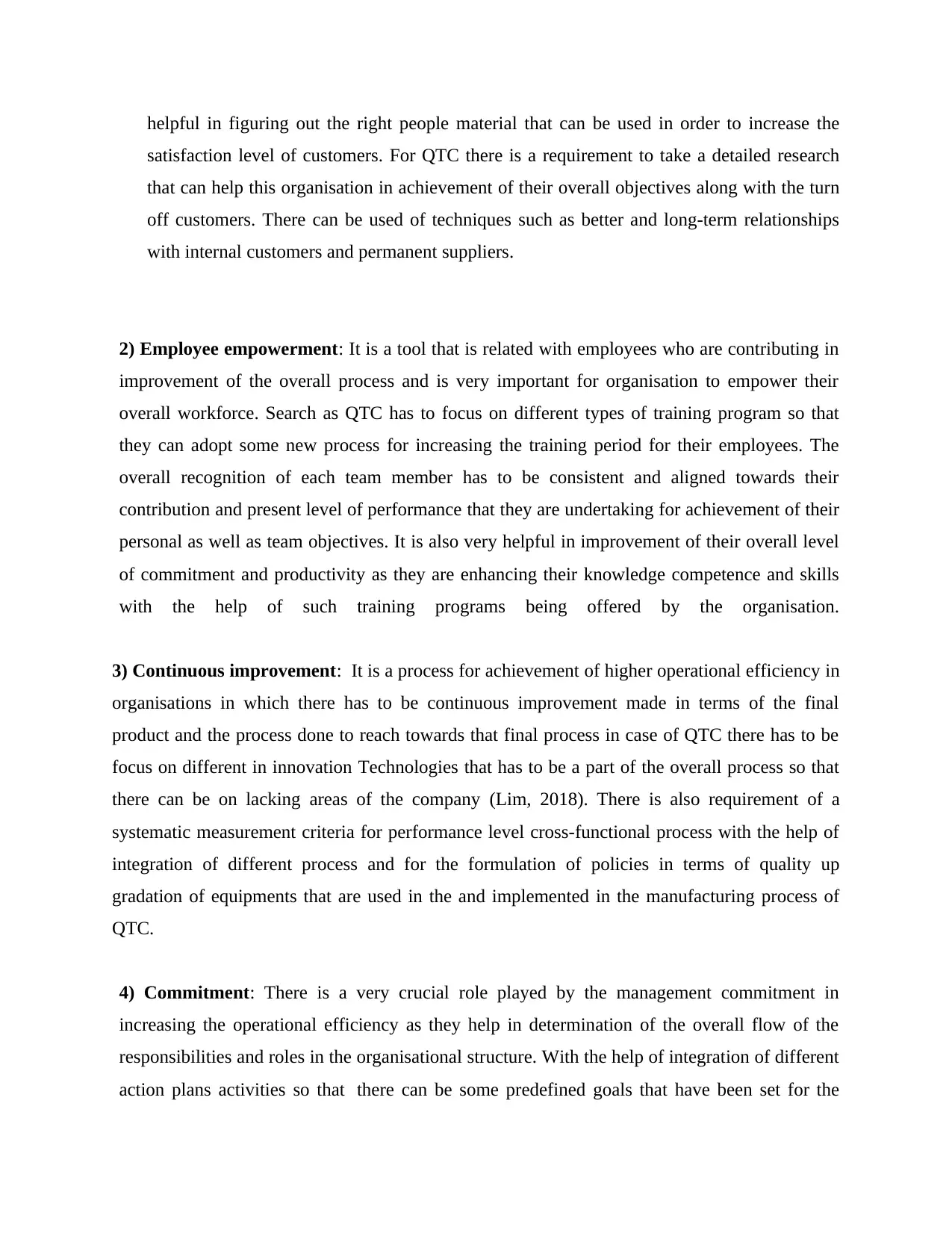
helpful in figuring out the right people material that can be used in order to increase the
satisfaction level of customers. For QTC there is a requirement to take a detailed research
that can help this organisation in achievement of their overall objectives along with the turn
off customers. There can be used of techniques such as better and long-term relationships
with internal customers and permanent suppliers.
2) Employee empowerment: It is a tool that is related with employees who are contributing in
improvement of the overall process and is very important for organisation to empower their
overall workforce. Search as QTC has to focus on different types of training program so that
they can adopt some new process for increasing the training period for their employees. The
overall recognition of each team member has to be consistent and aligned towards their
contribution and present level of performance that they are undertaking for achievement of their
personal as well as team objectives. It is also very helpful in improvement of their overall level
of commitment and productivity as they are enhancing their knowledge competence and skills
with the help of such training programs being offered by the organisation.
3) Continuous improvement: It is a process for achievement of higher operational efficiency in
organisations in which there has to be continuous improvement made in terms of the final
product and the process done to reach towards that final process in case of QTC there has to be
focus on different in innovation Technologies that has to be a part of the overall process so that
there can be on lacking areas of the company (Lim, 2018). There is also requirement of a
systematic measurement criteria for performance level cross-functional process with the help of
integration of different process and for the formulation of policies in terms of quality up
gradation of equipments that are used in the and implemented in the manufacturing process of
QTC.
4) Commitment: There is a very crucial role played by the management commitment in
increasing the operational efficiency as they help in determination of the overall flow of the
responsibilities and roles in the organisational structure. With the help of integration of different
action plans activities so that there can be some predefined goals that have been set for the
satisfaction level of customers. For QTC there is a requirement to take a detailed research
that can help this organisation in achievement of their overall objectives along with the turn
off customers. There can be used of techniques such as better and long-term relationships
with internal customers and permanent suppliers.
2) Employee empowerment: It is a tool that is related with employees who are contributing in
improvement of the overall process and is very important for organisation to empower their
overall workforce. Search as QTC has to focus on different types of training program so that
they can adopt some new process for increasing the training period for their employees. The
overall recognition of each team member has to be consistent and aligned towards their
contribution and present level of performance that they are undertaking for achievement of their
personal as well as team objectives. It is also very helpful in improvement of their overall level
of commitment and productivity as they are enhancing their knowledge competence and skills
with the help of such training programs being offered by the organisation.
3) Continuous improvement: It is a process for achievement of higher operational efficiency in
organisations in which there has to be continuous improvement made in terms of the final
product and the process done to reach towards that final process in case of QTC there has to be
focus on different in innovation Technologies that has to be a part of the overall process so that
there can be on lacking areas of the company (Lim, 2018). There is also requirement of a
systematic measurement criteria for performance level cross-functional process with the help of
integration of different process and for the formulation of policies in terms of quality up
gradation of equipments that are used in the and implemented in the manufacturing process of
QTC.
4) Commitment: There is a very crucial role played by the management commitment in
increasing the operational efficiency as they help in determination of the overall flow of the
responsibilities and roles in the organisational structure. With the help of integration of different
action plans activities so that there can be some predefined goals that have been set for the
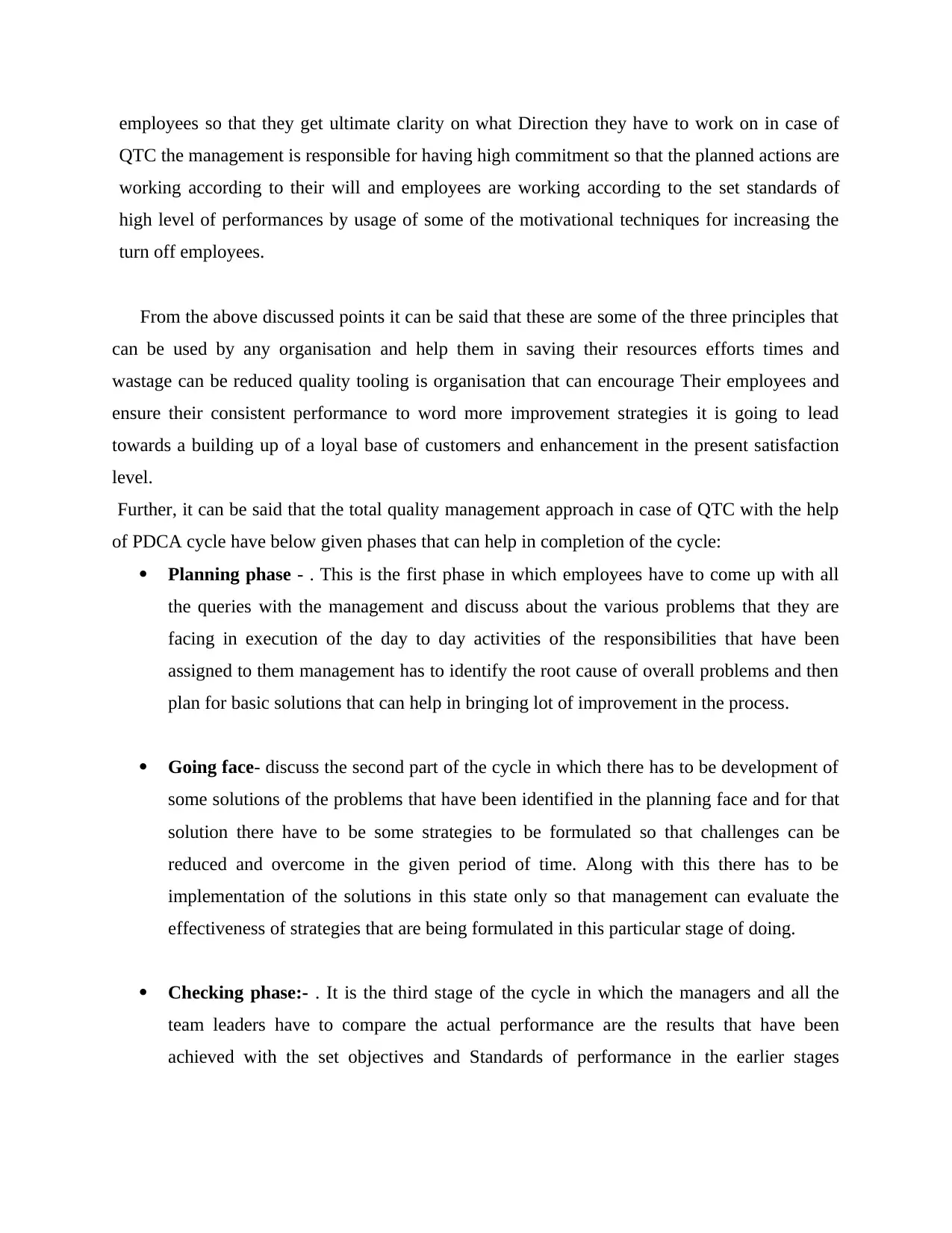
employees so that they get ultimate clarity on what Direction they have to work on in case of
QTC the management is responsible for having high commitment so that the planned actions are
working according to their will and employees are working according to the set standards of
high level of performances by usage of some of the motivational techniques for increasing the
turn off employees.
From the above discussed points it can be said that these are some of the three principles that
can be used by any organisation and help them in saving their resources efforts times and
wastage can be reduced quality tooling is organisation that can encourage Their employees and
ensure their consistent performance to word more improvement strategies it is going to lead
towards a building up of a loyal base of customers and enhancement in the present satisfaction
level.
Further, it can be said that the total quality management approach in case of QTC with the help
of PDCA cycle have below given phases that can help in completion of the cycle:
Planning phase - . This is the first phase in which employees have to come up with all
the queries with the management and discuss about the various problems that they are
facing in execution of the day to day activities of the responsibilities that have been
assigned to them management has to identify the root cause of overall problems and then
plan for basic solutions that can help in bringing lot of improvement in the process.
Going face- discuss the second part of the cycle in which there has to be development of
some solutions of the problems that have been identified in the planning face and for that
solution there have to be some strategies to be formulated so that challenges can be
reduced and overcome in the given period of time. Along with this there has to be
implementation of the solutions in this state only so that management can evaluate the
effectiveness of strategies that are being formulated in this particular stage of doing.
Checking phase:- . It is the third stage of the cycle in which the managers and all the
team leaders have to compare the actual performance are the results that have been
achieved with the set objectives and Standards of performance in the earlier stages
QTC the management is responsible for having high commitment so that the planned actions are
working according to their will and employees are working according to the set standards of
high level of performances by usage of some of the motivational techniques for increasing the
turn off employees.
From the above discussed points it can be said that these are some of the three principles that
can be used by any organisation and help them in saving their resources efforts times and
wastage can be reduced quality tooling is organisation that can encourage Their employees and
ensure their consistent performance to word more improvement strategies it is going to lead
towards a building up of a loyal base of customers and enhancement in the present satisfaction
level.
Further, it can be said that the total quality management approach in case of QTC with the help
of PDCA cycle have below given phases that can help in completion of the cycle:
Planning phase - . This is the first phase in which employees have to come up with all
the queries with the management and discuss about the various problems that they are
facing in execution of the day to day activities of the responsibilities that have been
assigned to them management has to identify the root cause of overall problems and then
plan for basic solutions that can help in bringing lot of improvement in the process.
Going face- discuss the second part of the cycle in which there has to be development of
some solutions of the problems that have been identified in the planning face and for that
solution there have to be some strategies to be formulated so that challenges can be
reduced and overcome in the given period of time. Along with this there has to be
implementation of the solutions in this state only so that management can evaluate the
effectiveness of strategies that are being formulated in this particular stage of doing.
Checking phase:- . It is the third stage of the cycle in which the managers and all the
team leaders have to compare the actual performance are the results that have been
achieved with the set objectives and Standards of performance in the earlier stages
⊘ This is a preview!⊘
Do you want full access?
Subscribe today to unlock all pages.

Trusted by 1+ million students worldwide
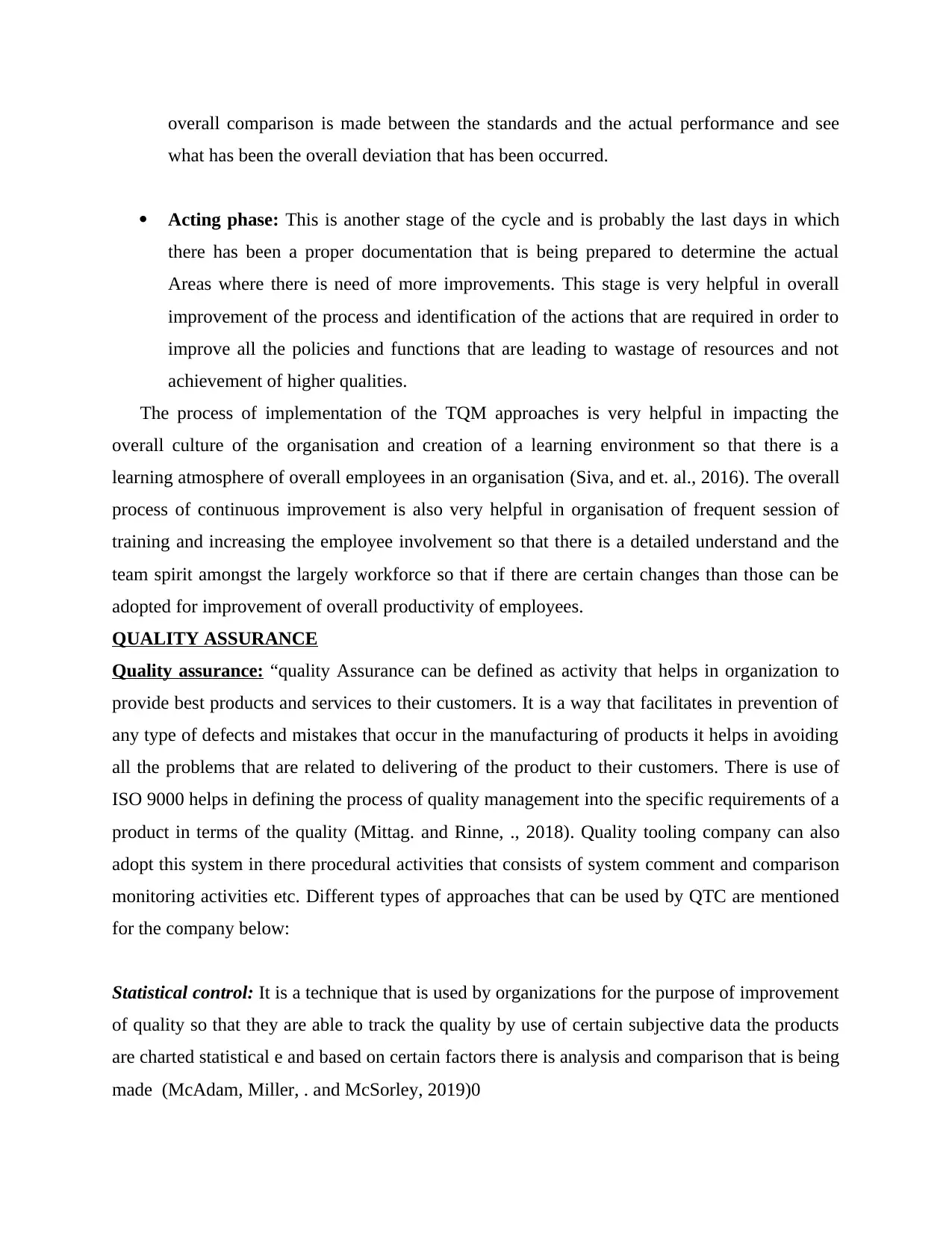
overall comparison is made between the standards and the actual performance and see
what has been the overall deviation that has been occurred.
Acting phase: This is another stage of the cycle and is probably the last days in which
there has been a proper documentation that is being prepared to determine the actual
Areas where there is need of more improvements. This stage is very helpful in overall
improvement of the process and identification of the actions that are required in order to
improve all the policies and functions that are leading to wastage of resources and not
achievement of higher qualities.
The process of implementation of the TQM approaches is very helpful in impacting the
overall culture of the organisation and creation of a learning environment so that there is a
learning atmosphere of overall employees in an organisation (Siva, and et. al., 2016). The overall
process of continuous improvement is also very helpful in organisation of frequent session of
training and increasing the employee involvement so that there is a detailed understand and the
team spirit amongst the largely workforce so that if there are certain changes than those can be
adopted for improvement of overall productivity of employees.
QUALITY ASSURANCE
Quality assurance: “quality Assurance can be defined as activity that helps in organization to
provide best products and services to their customers. It is a way that facilitates in prevention of
any type of defects and mistakes that occur in the manufacturing of products it helps in avoiding
all the problems that are related to delivering of the product to their customers. There is use of
ISO 9000 helps in defining the process of quality management into the specific requirements of a
product in terms of the quality (Mittag. and Rinne, ., 2018). Quality tooling company can also
adopt this system in there procedural activities that consists of system comment and comparison
monitoring activities etc. Different types of approaches that can be used by QTC are mentioned
for the company below:
Statistical control: It is a technique that is used by organizations for the purpose of improvement
of quality so that they are able to track the quality by use of certain subjective data the products
are charted statistical e and based on certain factors there is analysis and comparison that is being
made (McAdam, Miller, . and McSorley, 2019)0
what has been the overall deviation that has been occurred.
Acting phase: This is another stage of the cycle and is probably the last days in which
there has been a proper documentation that is being prepared to determine the actual
Areas where there is need of more improvements. This stage is very helpful in overall
improvement of the process and identification of the actions that are required in order to
improve all the policies and functions that are leading to wastage of resources and not
achievement of higher qualities.
The process of implementation of the TQM approaches is very helpful in impacting the
overall culture of the organisation and creation of a learning environment so that there is a
learning atmosphere of overall employees in an organisation (Siva, and et. al., 2016). The overall
process of continuous improvement is also very helpful in organisation of frequent session of
training and increasing the employee involvement so that there is a detailed understand and the
team spirit amongst the largely workforce so that if there are certain changes than those can be
adopted for improvement of overall productivity of employees.
QUALITY ASSURANCE
Quality assurance: “quality Assurance can be defined as activity that helps in organization to
provide best products and services to their customers. It is a way that facilitates in prevention of
any type of defects and mistakes that occur in the manufacturing of products it helps in avoiding
all the problems that are related to delivering of the product to their customers. There is use of
ISO 9000 helps in defining the process of quality management into the specific requirements of a
product in terms of the quality (Mittag. and Rinne, ., 2018). Quality tooling company can also
adopt this system in there procedural activities that consists of system comment and comparison
monitoring activities etc. Different types of approaches that can be used by QTC are mentioned
for the company below:
Statistical control: It is a technique that is used by organizations for the purpose of improvement
of quality so that they are able to track the quality by use of certain subjective data the products
are charted statistical e and based on certain factors there is analysis and comparison that is being
made (McAdam, Miller, . and McSorley, 2019)0
Paraphrase This Document
Need a fresh take? Get an instant paraphrase of this document with our AI Paraphraser
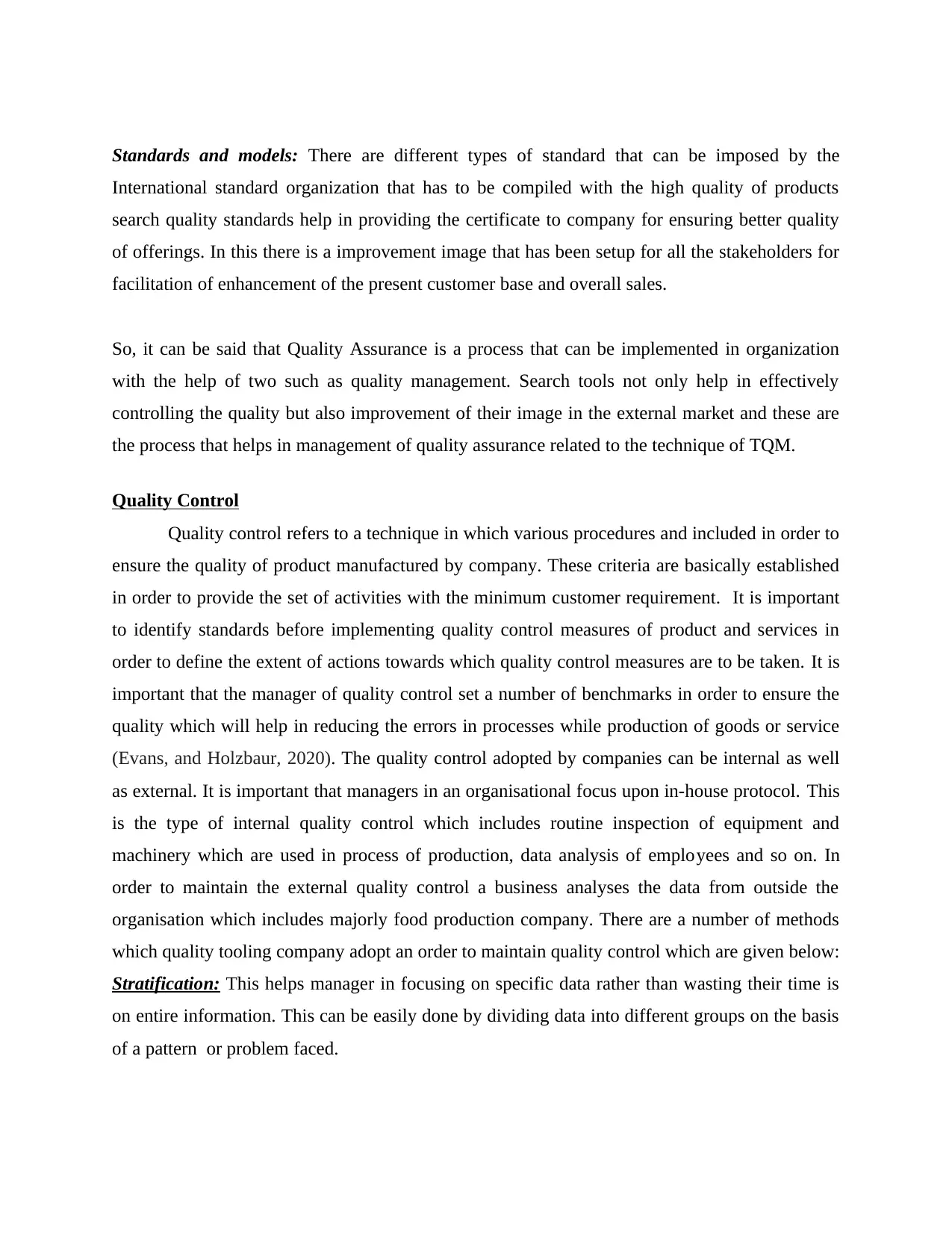
Standards and models: There are different types of standard that can be imposed by the
International standard organization that has to be compiled with the high quality of products
search quality standards help in providing the certificate to company for ensuring better quality
of offerings. In this there is a improvement image that has been setup for all the stakeholders for
facilitation of enhancement of the present customer base and overall sales.
So, it can be said that Quality Assurance is a process that can be implemented in organization
with the help of two such as quality management. Search tools not only help in effectively
controlling the quality but also improvement of their image in the external market and these are
the process that helps in management of quality assurance related to the technique of TQM.
Quality Control
Quality control refers to a technique in which various procedures and included in order to
ensure the quality of product manufactured by company. These criteria are basically established
in order to provide the set of activities with the minimum customer requirement. It is important
to identify standards before implementing quality control measures of product and services in
order to define the extent of actions towards which quality control measures are to be taken. It is
important that the manager of quality control set a number of benchmarks in order to ensure the
quality which will help in reducing the errors in processes while production of goods or service
(Evans, and Holzbaur, 2020). The quality control adopted by companies can be internal as well
as external. It is important that managers in an organisational focus upon in-house protocol. This
is the type of internal quality control which includes routine inspection of equipment and
machinery which are used in process of production, data analysis of employees and so on. In
order to maintain the external quality control a business analyses the data from outside the
organisation which includes majorly food production company. There are a number of methods
which quality tooling company adopt an order to maintain quality control which are given below:
Stratification: This helps manager in focusing on specific data rather than wasting their time is
on entire information. This can be easily done by dividing data into different groups on the basis
of a pattern or problem faced.
International standard organization that has to be compiled with the high quality of products
search quality standards help in providing the certificate to company for ensuring better quality
of offerings. In this there is a improvement image that has been setup for all the stakeholders for
facilitation of enhancement of the present customer base and overall sales.
So, it can be said that Quality Assurance is a process that can be implemented in organization
with the help of two such as quality management. Search tools not only help in effectively
controlling the quality but also improvement of their image in the external market and these are
the process that helps in management of quality assurance related to the technique of TQM.
Quality Control
Quality control refers to a technique in which various procedures and included in order to
ensure the quality of product manufactured by company. These criteria are basically established
in order to provide the set of activities with the minimum customer requirement. It is important
to identify standards before implementing quality control measures of product and services in
order to define the extent of actions towards which quality control measures are to be taken. It is
important that the manager of quality control set a number of benchmarks in order to ensure the
quality which will help in reducing the errors in processes while production of goods or service
(Evans, and Holzbaur, 2020). The quality control adopted by companies can be internal as well
as external. It is important that managers in an organisational focus upon in-house protocol. This
is the type of internal quality control which includes routine inspection of equipment and
machinery which are used in process of production, data analysis of employees and so on. In
order to maintain the external quality control a business analyses the data from outside the
organisation which includes majorly food production company. There are a number of methods
which quality tooling company adopt an order to maintain quality control which are given below:
Stratification: This helps manager in focusing on specific data rather than wasting their time is
on entire information. This can be easily done by dividing data into different groups on the basis
of a pattern or problem faced.
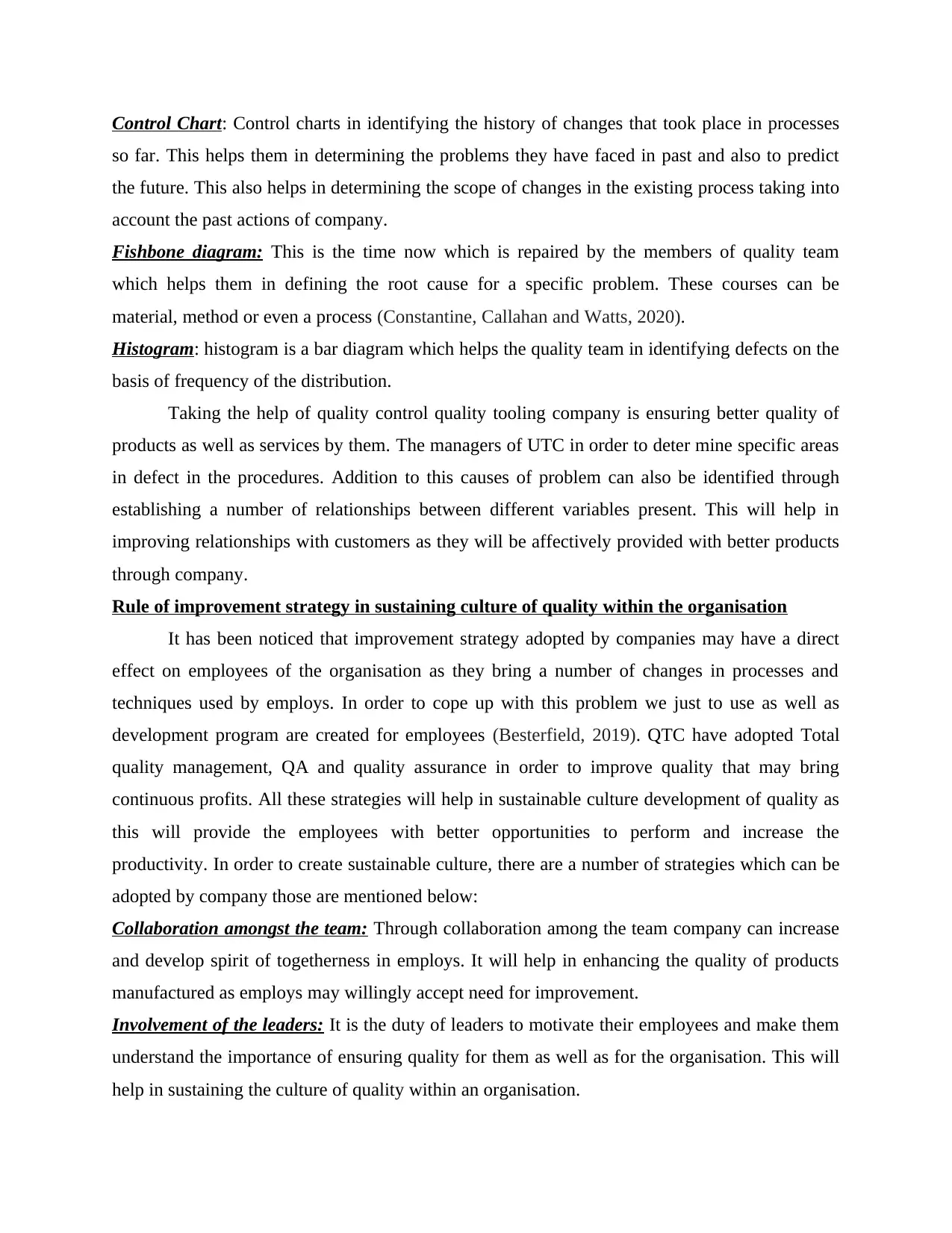
Control Chart: Control charts in identifying the history of changes that took place in processes
so far. This helps them in determining the problems they have faced in past and also to predict
the future. This also helps in determining the scope of changes in the existing process taking into
account the past actions of company.
Fishbone diagram: This is the time now which is repaired by the members of quality team
which helps them in defining the root cause for a specific problem. These courses can be
material, method or even a process (Constantine, Callahan and Watts, 2020).
Histogram: histogram is a bar diagram which helps the quality team in identifying defects on the
basis of frequency of the distribution.
Taking the help of quality control quality tooling company is ensuring better quality of
products as well as services by them. The managers of UTC in order to deter mine specific areas
in defect in the procedures. Addition to this causes of problem can also be identified through
establishing a number of relationships between different variables present. This will help in
improving relationships with customers as they will be affectively provided with better products
through company.
Rule of improvement strategy in sustaining culture of quality within the organisation
It has been noticed that improvement strategy adopted by companies may have a direct
effect on employees of the organisation as they bring a number of changes in processes and
techniques used by employs. In order to cope up with this problem we just to use as well as
development program are created for employees (Besterfield, 2019). QTC have adopted Total
quality management, QA and quality assurance in order to improve quality that may bring
continuous profits. All these strategies will help in sustainable culture development of quality as
this will provide the employees with better opportunities to perform and increase the
productivity. In order to create sustainable culture, there are a number of strategies which can be
adopted by company those are mentioned below:
Collaboration amongst the team: Through collaboration among the team company can increase
and develop spirit of togetherness in employs. It will help in enhancing the quality of products
manufactured as employs may willingly accept need for improvement.
Involvement of the leaders: It is the duty of leaders to motivate their employees and make them
understand the importance of ensuring quality for them as well as for the organisation. This will
help in sustaining the culture of quality within an organisation.
so far. This helps them in determining the problems they have faced in past and also to predict
the future. This also helps in determining the scope of changes in the existing process taking into
account the past actions of company.
Fishbone diagram: This is the time now which is repaired by the members of quality team
which helps them in defining the root cause for a specific problem. These courses can be
material, method or even a process (Constantine, Callahan and Watts, 2020).
Histogram: histogram is a bar diagram which helps the quality team in identifying defects on the
basis of frequency of the distribution.
Taking the help of quality control quality tooling company is ensuring better quality of
products as well as services by them. The managers of UTC in order to deter mine specific areas
in defect in the procedures. Addition to this causes of problem can also be identified through
establishing a number of relationships between different variables present. This will help in
improving relationships with customers as they will be affectively provided with better products
through company.
Rule of improvement strategy in sustaining culture of quality within the organisation
It has been noticed that improvement strategy adopted by companies may have a direct
effect on employees of the organisation as they bring a number of changes in processes and
techniques used by employs. In order to cope up with this problem we just to use as well as
development program are created for employees (Besterfield, 2019). QTC have adopted Total
quality management, QA and quality assurance in order to improve quality that may bring
continuous profits. All these strategies will help in sustainable culture development of quality as
this will provide the employees with better opportunities to perform and increase the
productivity. In order to create sustainable culture, there are a number of strategies which can be
adopted by company those are mentioned below:
Collaboration amongst the team: Through collaboration among the team company can increase
and develop spirit of togetherness in employs. It will help in enhancing the quality of products
manufactured as employs may willingly accept need for improvement.
Involvement of the leaders: It is the duty of leaders to motivate their employees and make them
understand the importance of ensuring quality for them as well as for the organisation. This will
help in sustaining the culture of quality within an organisation.
⊘ This is a preview!⊘
Do you want full access?
Subscribe today to unlock all pages.

Trusted by 1+ million students worldwide
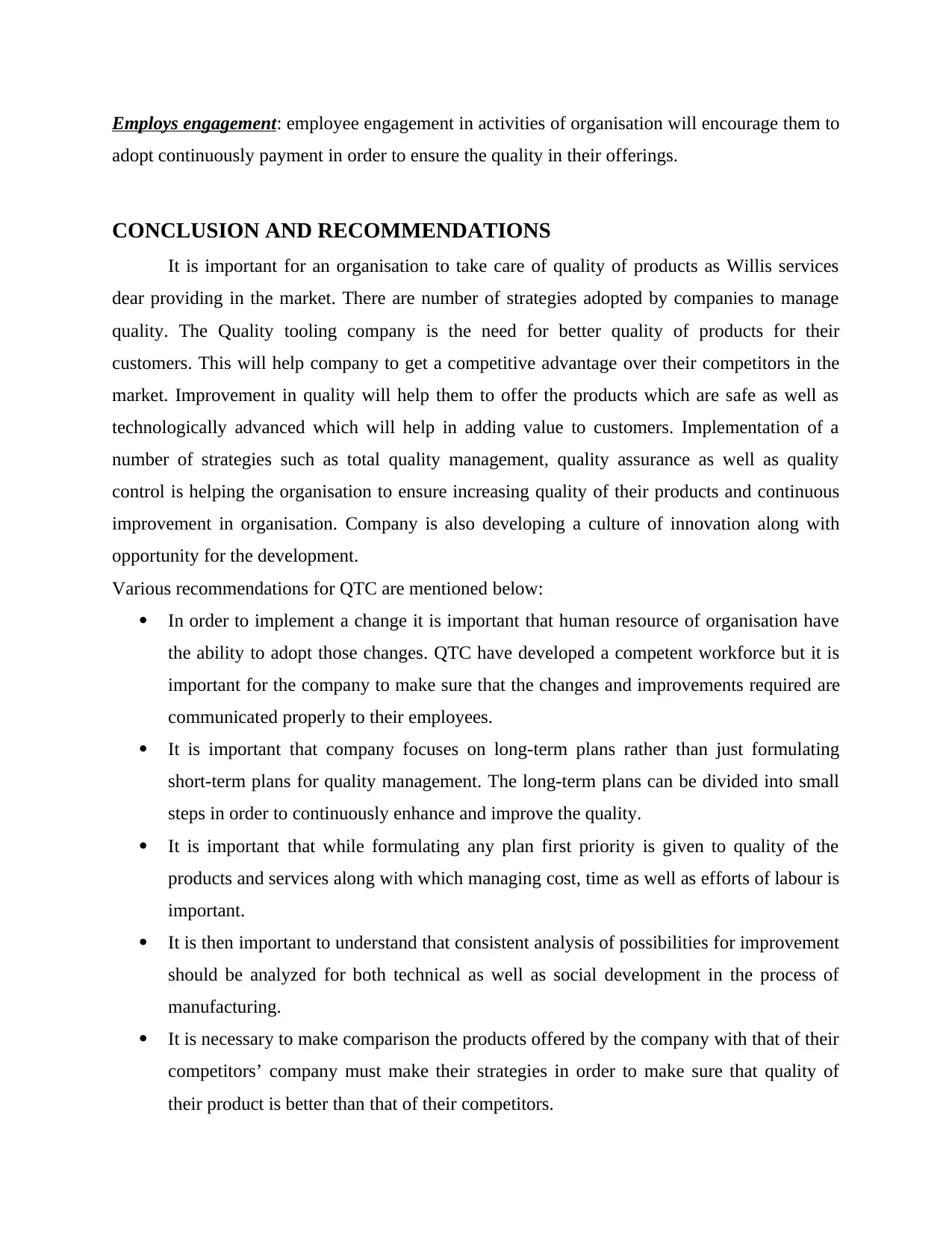
Employs engagement: employee engagement in activities of organisation will encourage them to
adopt continuously payment in order to ensure the quality in their offerings.
CONCLUSION AND RECOMMENDATIONS
It is important for an organisation to take care of quality of products as Willis services
dear providing in the market. There are number of strategies adopted by companies to manage
quality. The Quality tooling company is the need for better quality of products for their
customers. This will help company to get a competitive advantage over their competitors in the
market. Improvement in quality will help them to offer the products which are safe as well as
technologically advanced which will help in adding value to customers. Implementation of a
number of strategies such as total quality management, quality assurance as well as quality
control is helping the organisation to ensure increasing quality of their products and continuous
improvement in organisation. Company is also developing a culture of innovation along with
opportunity for the development.
Various recommendations for QTC are mentioned below:
In order to implement a change it is important that human resource of organisation have
the ability to adopt those changes. QTC have developed a competent workforce but it is
important for the company to make sure that the changes and improvements required are
communicated properly to their employees.
It is important that company focuses on long-term plans rather than just formulating
short-term plans for quality management. The long-term plans can be divided into small
steps in order to continuously enhance and improve the quality.
It is important that while formulating any plan first priority is given to quality of the
products and services along with which managing cost, time as well as efforts of labour is
important.
It is then important to understand that consistent analysis of possibilities for improvement
should be analyzed for both technical as well as social development in the process of
manufacturing.
It is necessary to make comparison the products offered by the company with that of their
competitors’ company must make their strategies in order to make sure that quality of
their product is better than that of their competitors.
adopt continuously payment in order to ensure the quality in their offerings.
CONCLUSION AND RECOMMENDATIONS
It is important for an organisation to take care of quality of products as Willis services
dear providing in the market. There are number of strategies adopted by companies to manage
quality. The Quality tooling company is the need for better quality of products for their
customers. This will help company to get a competitive advantage over their competitors in the
market. Improvement in quality will help them to offer the products which are safe as well as
technologically advanced which will help in adding value to customers. Implementation of a
number of strategies such as total quality management, quality assurance as well as quality
control is helping the organisation to ensure increasing quality of their products and continuous
improvement in organisation. Company is also developing a culture of innovation along with
opportunity for the development.
Various recommendations for QTC are mentioned below:
In order to implement a change it is important that human resource of organisation have
the ability to adopt those changes. QTC have developed a competent workforce but it is
important for the company to make sure that the changes and improvements required are
communicated properly to their employees.
It is important that company focuses on long-term plans rather than just formulating
short-term plans for quality management. The long-term plans can be divided into small
steps in order to continuously enhance and improve the quality.
It is important that while formulating any plan first priority is given to quality of the
products and services along with which managing cost, time as well as efforts of labour is
important.
It is then important to understand that consistent analysis of possibilities for improvement
should be analyzed for both technical as well as social development in the process of
manufacturing.
It is necessary to make comparison the products offered by the company with that of their
competitors’ company must make their strategies in order to make sure that quality of
their product is better than that of their competitors.
Paraphrase This Document
Need a fresh take? Get an instant paraphrase of this document with our AI Paraphraser
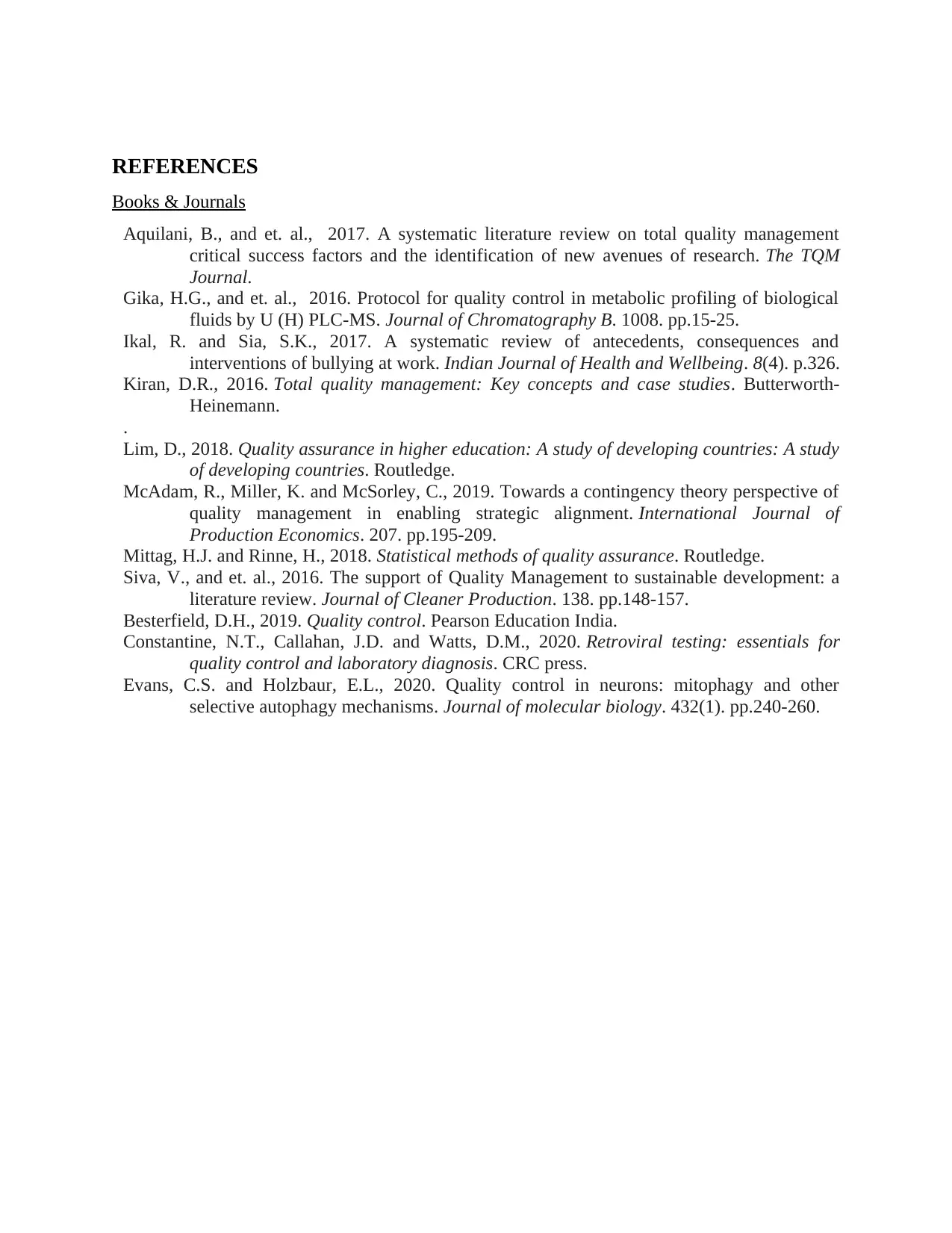
REFERENCES
Books & Journals
Aquilani, B., and et. al., 2017. A systematic literature review on total quality management
critical success factors and the identification of new avenues of research. The TQM
Journal.
Gika, H.G., and et. al., 2016. Protocol for quality control in metabolic profiling of biological
fluids by U (H) PLC-MS. Journal of Chromatography B. 1008. pp.15-25.
Ikal, R. and Sia, S.K., 2017. A systematic review of antecedents, consequences and
interventions of bullying at work. Indian Journal of Health and Wellbeing. 8(4). p.326.
Kiran, D.R., 2016. Total quality management: Key concepts and case studies. Butterworth-
Heinemann.
.
Lim, D., 2018. Quality assurance in higher education: A study of developing countries: A study
of developing countries. Routledge.
McAdam, R., Miller, K. and McSorley, C., 2019. Towards a contingency theory perspective of
quality management in enabling strategic alignment. International Journal of
Production Economics. 207. pp.195-209.
Mittag, H.J. and Rinne, H., 2018. Statistical methods of quality assurance. Routledge.
Siva, V., and et. al., 2016. The support of Quality Management to sustainable development: a
literature review. Journal of Cleaner Production. 138. pp.148-157.
Besterfield, D.H., 2019. Quality control. Pearson Education India.
Constantine, N.T., Callahan, J.D. and Watts, D.M., 2020. Retroviral testing: essentials for
quality control and laboratory diagnosis. CRC press.
Evans, C.S. and Holzbaur, E.L., 2020. Quality control in neurons: mitophagy and other
selective autophagy mechanisms. Journal of molecular biology. 432(1). pp.240-260.
Books & Journals
Aquilani, B., and et. al., 2017. A systematic literature review on total quality management
critical success factors and the identification of new avenues of research. The TQM
Journal.
Gika, H.G., and et. al., 2016. Protocol for quality control in metabolic profiling of biological
fluids by U (H) PLC-MS. Journal of Chromatography B. 1008. pp.15-25.
Ikal, R. and Sia, S.K., 2017. A systematic review of antecedents, consequences and
interventions of bullying at work. Indian Journal of Health and Wellbeing. 8(4). p.326.
Kiran, D.R., 2016. Total quality management: Key concepts and case studies. Butterworth-
Heinemann.
.
Lim, D., 2018. Quality assurance in higher education: A study of developing countries: A study
of developing countries. Routledge.
McAdam, R., Miller, K. and McSorley, C., 2019. Towards a contingency theory perspective of
quality management in enabling strategic alignment. International Journal of
Production Economics. 207. pp.195-209.
Mittag, H.J. and Rinne, H., 2018. Statistical methods of quality assurance. Routledge.
Siva, V., and et. al., 2016. The support of Quality Management to sustainable development: a
literature review. Journal of Cleaner Production. 138. pp.148-157.
Besterfield, D.H., 2019. Quality control. Pearson Education India.
Constantine, N.T., Callahan, J.D. and Watts, D.M., 2020. Retroviral testing: essentials for
quality control and laboratory diagnosis. CRC press.
Evans, C.S. and Holzbaur, E.L., 2020. Quality control in neurons: mitophagy and other
selective autophagy mechanisms. Journal of molecular biology. 432(1). pp.240-260.
1 out of 11
Related Documents
Your All-in-One AI-Powered Toolkit for Academic Success.
+13062052269
info@desklib.com
Available 24*7 on WhatsApp / Email
![[object Object]](/_next/static/media/star-bottom.7253800d.svg)
Unlock your academic potential
Copyright © 2020–2025 A2Z Services. All Rights Reserved. Developed and managed by ZUCOL.





